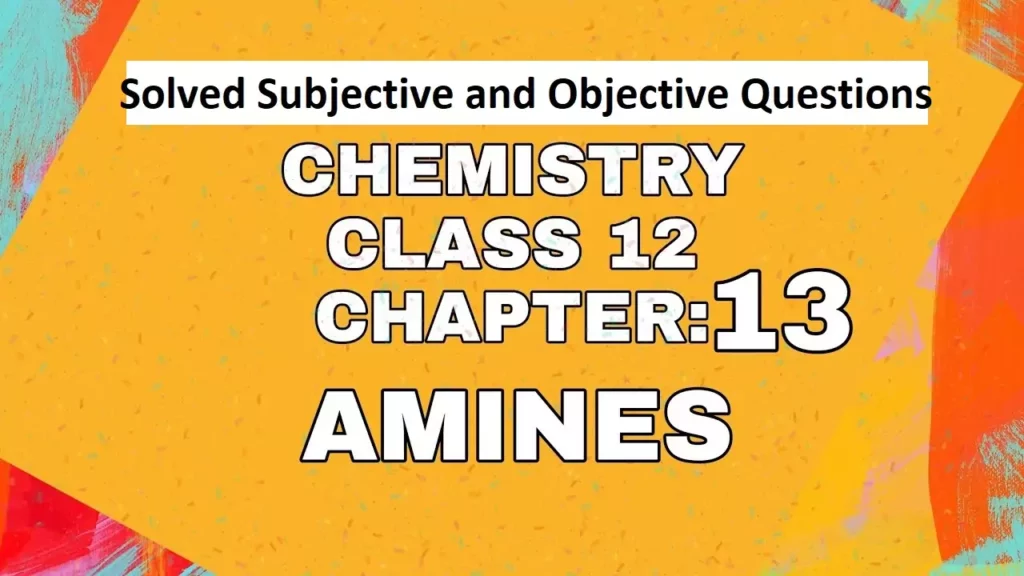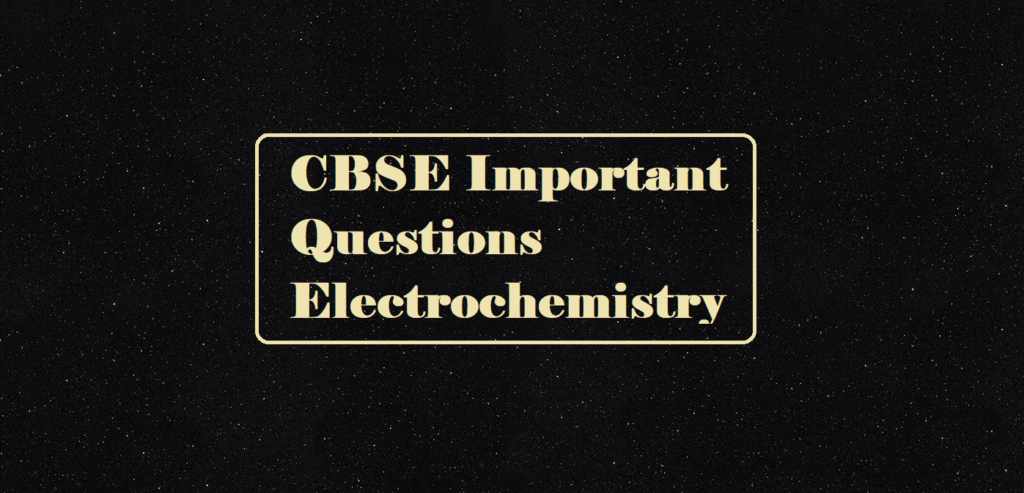Solved Subjective and Objective Questions of Amines
Solved Subjective and Objective Questions of Amines:
Q1. Why Amines are basic in nature?
Ans 1. The reaction of amines with mineral acids to form ammonium salts shows that these are basic in nature. Amines have an unshared pair of electrons on nitrogen atom due to which they behave as Lewis base.
Q2. In Alkylamines and ammonia which is more basic and why?
Ans 2. Due to the electron releasing nature of the alkyl group, it (R) pushes electrons towards nitrogen and thus makes the unshared electron pair more available for sharing with the proton of the acid. Hence, alkyl amines are stronger bases than ammonia.
Q3. Arrange the following in decreasing order of basic strength in the gaseous phase
CH3NH2, (CH3)2NH, NH3, (CH3)3N
Ans 3. (CH3)3N > (CH3)2NH >CH3NH2 > NH3
Q4. In Arylamine and alkylamine which is more basic and why?
Ans 4. Alkylamine is more basic due to the +I effect of the R group but in the arylamine lone pair of N are stabilized by resonance, they are not so free to attack. Therefore Alkylamine is more basic than arylamine.
Q5. Arrange the following in increasing order of basic strength: C6H5NH2, CH3NH2, NH3
Ans 5. C6H5NH2 < NH3 < CH3NH2.
Q6. pKb of aniline is more than that of methylamine, why.
Ans 6. Because aniline is less basic than methylamine due to stabilization lone pair of N by resonance effect.
Q7. Arrange the following in increasing order of their basic strength:
(i) C2H5NH2, C6H5NH2, NH3, C6H5CH2NH2 and (C2H5)2NH
(ii) C2H5NH2, (C2H5)2NH, (C2H5)3N, C6H5NH2
(iii) CH3NH2, (CH3)2NH, (CH3)3N, C6H5NH2, C6H5CH2NH2.
Ans 7. (i) C6H5NH2 < NH3 < C6H5CH2NH2 < C2H5NH2 < (C2H5)2NH
(ii) C6H5NH2 < C2H5NH2 < (C2H5)3N < (C2H5)2NH
(iii) C6H5NH2 < C6H5CH2NH2 < (CH3)3N < CH3NH2 < (CH3)2NH
Q8. Arrange the following:
(i) In decreasing order of the pKb values: C2H5NH2, C6H5NHCH3, (C2H5)2NH and C6H5NH2
(ii) In increasing order of basic strength: C6H5NH2, C6H5N(CH3)2, (C2H5)2NH and CH3NH2
Ans 8. (i) C6H5NH2 > C6H5NHCH3 > C2H5NH2 > (C2H5)2NH
(ii) C6H5NH2 < C6H5N(CH3)2 < CH3NH2 < (C2H5)2NH
Q9. Arrange the following:In increasing order of basic strength:
(i) Aniline, p-nitroaniline, and p-toluidine
(ii) C6H5NH2, C6H5NHCH3, C6H5CH2NH2.
Ans. (i) p-nitroaniline < Aniline < p-toluidine
(ii) C6H5NH2 < C6H5NHCH3 < C6H5CH2NH2.
Q10. Arrange the following In decreasing order of basic strength :
(i) C2H5NH2, (C2H5)2NH, NH3, (C2H5)3N
(ii) (CH3)2NH, (CH3)3N, NH3, CH3NH2
Ans. (i) (C2H5)2NH > (C2H5)3N > C2H5NH2 > NH3
(ii) (CH3)2NH > CH3NH2 > (CH3)3N > NH3
Solved Subjective and Objective Questions of Amines
Que 11. Name two methods by which primary secondary and tertiary amines be used for separation.
Ans 11. (1) Hinsberg’s method:- In this mixture of amines is treated with benzene sulphonyl chloride followed by the addition of to make the contents alkaline.

(2) Hoffmann’s method:- In this mixture of amines is treated with diethyl oxalate

Que 12. Write short notes on the following.
(a) Hoffmann’s bromamide reaction
(b) Benzoylation Reaction
(c) Mendius Reaction
Ans 12. (i) Primary acid amides on reaction within the presence of alkalies at about give primary amines. The amine formed by this method has one carbon atom less than the parent amide.

(ii) Benzoyaltion refers to the replacement of an atom of the amino group by the benzoyl group. Primary or secondary amines react with benzoyl chloride in the presence of a base like a pyridine or aqueous benzoyl derivation.

(iii) The reduction of alkyl cyanides is named as Mendius Reaction. The alkyl cyanides on reduction with reducing agents such as LiAlH4, Na/C2H5OH, or H2/Raney Ni give 10 amines.
![]()
Que 13. An aromatic compound ‘A’ on treatment with aqueous ammonia and heating form compound ‘B’ which on heating with and forms a compound ‘C’ of the molecular formula. Write the structures and IUPAC names of compounds.
Ans 13. Compounds A, B, and C are:

Que 14. Give Reasons for the following
(i) Aniline is a weaker base than cyclohexylamine
(ii) Ethyl alcohol has a higher boiling point than ethyl amines.
(iii) Aniline cannot be prepared by Gabriel phthalimide synthesis.
(iv) Silver chloride dissolves in an aqueous methylamine solution.
(v) Sulphanilic acid is insoluble in water but soluble in the aqueous base and aqueous mineral acids are taken separately.
Ans 14. (i) In aniline, the lone pair of electrons of nitrogen atom is involved in resonance with benzene ring hence is not easily available for donation, therefore, it is less basic than cyclohexylamine.
(ii) Because there is stranger intermolecular H-Bonding in ethanol due to more electronegative of oxygen than Nitrogen.
(iii) It is because aryl halide has a double bond character therefore C-Cl bond will not break easily that is why we cannot prepare aniline by using Gabriel phthalimide synthesis.
(iv) AgCl dissolves in methylamine due to the formation of complex compounds.
![]()
(v) Sulphanilic acid forms zwitter ion, therefore it is soluble in both bases and mineral acids but insoluble in water due to greater hydrocarbon part.
Que 15. Write reaction and conditions for the following conversions.
(i) Aniline to p-nitro aniline
(ii) chloroethane to N-N-Diethylethanamine
(iii) Benzyl chloride to Benzylamine
Ans 15.

Solved Subjective and Objective Questions of Amines
Multiple Choice Questions (MCQs)
Que 16. Which of the following is a 3° amine?
(i) 1-methylcyclohexylamine
(ii) Triethylamine
(iii) tert-butylamine
(iv) N-methylaniline
Ans 16. (ii)
Explanation: The structure of given amines are as follows:

Que 17. The correct IUPAC name for CH2=CHCH2NHCH3 is
(i) Allylmethylamine
(ii) 2-amino-4-pentene
(iii) 4-aminopent-1-ene
(iv) N-methylprop-2-en-1-amine
Ans 17. (iv)
Explanation: IUPAC name of the compound is N-methylprop-2-en-1-amine.
Que 18. Amongst the following, the strongest base in an aqueous medium is _.
(i) CH3NH2
(ii) NCCH2NH2
(iii) (CH3)2 NH
(iv) C6H5NHCH3
Ans 18. (iii)
Explanation: Due to the electron releasing nature of the alkyl group, it (R) pushes electrons towards nitrogen and thus makes the unshared electron pair more available for sharing with the proton of the acid. Moreover, the substituted ammonium ion formed from the amine gets stabilized due to dispersal of the positive charge by the +I effect of the alkyl group. Hence, alkylamines are stronger bases than ammonia. Thus, the basic nature of aliphatic amines should increase with an increase in the number of alkyl groups.
Que 19. In order to prepare a 1 amine from an alkyl halide with simultaneous addition of one group in the carbon chain, the reagent used as a source of nitrogen is
(i) Sodium amide, NaNH2
(ii) Sodium azide, NaN3
(iii) Potassium cyanide, KCN
(iv) Potassium phthalimide, C6H4(CO)2N–K+
Ans 19. (iii)
Que 20. The source of nitrogen in Gabriel synthesis of amines is_______ _.
(i) Sodium azide, NaN3
(ii) Sodium nitrite, NaNO2
(iii) Potassium cyanide, KCN
(iv) Potassium phthalimide, C6H4(CO)2N–K+
Ans 20. (iv)
Explanation: Gabriel synthesis is used for the preparation of primary amines. Phthalimide on treatment with ethanolic potassium hydroxide forms potassium salt of phthalimide which on heating with alkyl halide followed by alkaline hydrolysis produces the corresponding primary amine. Aromatic primary amines cannot be prepared by this method because aryl halides do not undergo nucleophilic substitution with the anion formed by phthalimide.

Solved Subjective and Objective Questions of Amines
Que 21. Amongst the given set of reactants, the most appropriate for preparing 2° amine is _____.
(i) 2° R—Br + NH3
(ii) 2° R—Br + NaCN followed by H2/Pt
(iii) 1° R—NH2 + RCHO followed by H2/Pt
(iv) 1° R—Br (2 mol) + potassium phthalimide followed by H3O+/heat
Ans 21. (iii)
Explanation: Chemical transformation can be shown as

While other given sets of reactants give primary amine only.
Que 22. The best reagent for converting 2–phenylpropanamide into 2-phenylpropanamine is _.
(i) excess H2
(ii) Br2 in aqueous NaOH
(ii) iodine in the presence of red phosphorus
(iv) LiAlH4 in ether
Ans 22. (iv)
Explanation: The best reagent for converting 2-phenylpropanamide into 2- phenylpropanamine is LiAlH4 in ether. The reaction is as given below:

Que 23. The best reagent for converting, 2-phenylpropanamide into 1- phenylethanamine is _.
(i) excess H2/Pt
(ii) NaOH/Br2
(iii) NaBH4/methanol
(iv) LiAlH4/ether
Ans 23. (ii)
Explanation: By Hoffmann bromamide reaction with NaOH/Br2

Que 24. Hoffmann Bromamide Degradation reaction is shown by_______.
(i) ArNH2
(ii) ArCONH2
(iii) ArNO2
(iv) ArCH2NH2
Ans 24. (ii)
Explanation: Hoffmann developed a method for the preparation of primary amines by treating an amide with bromine in an aqueous or ethanolic solution of sodium hydroxide. In this degradation reaction, migration of an alkyl or aryl group takes place from carbonyl carbon of the amide to the nitrogen atom.
Que 25. The correct increasing order of basic strength for the following compounds is………………

(i) II < III < I
(ii) III < I < II
(iii) III < II < I
(iv) II < I < III
Ans 25. (iv)
Explanation: The correct increasing order of basic strength is as follows:

The greater the electron density towards the ring, the greater will be its basic strength.
The electron-withdrawing group decreases basic strength while the electron-donating group increases basic strength.
Que 26. Methylamine reacts with HNO2 to form______.
(i) CH3—O—N=O
(ii) CH3—O—CH3
(iii) CH3OH
(iv) CH3CHO
Ans 26. (iii)
Explanation:
![]()
Que 27. The gas evolved when methylamine reacts with nitrous acid is _.
(i) NH3
(ii) N2
(iii) H2
(iv) C2H6
Ans 27. (ii)
Explanation: Primary aliphatic amines react with nitrous acid to form aliphatic diazonium salts which being unstable, liberate nitrogen gas quantitatively and alcohol.
Que 28. In the nitration of benzene using a mixture of conc.H2SO4 and conc.HNO3, the species which initiates the reaction is _.
(i) NO2
(ii) NO+
(iii) NO2+
(iv) NO2–
Ans 28. (iii)
Explanation: Nitration of benzene using a mixture of conc. H2SO4 and conc. HNO3 proceeds as

This reaction is known as the electrophilic substitution reaction.
Que 29. Reduction of aromatic nitro compounds using Fe and HCl gives _.
(i) aromatic oxime
(ii) aromatic hydrocarbon
(iii) aromatic primary amine
(iv) aromatic amide
Ans 29. (iii)
Explanation:

Que 30. Acid anhydrides on reaction with primary amines give_______ _.
(i) amide
(ii) imide
(iii) secondary amine
(iv) imine
Ans 30. (i)
Explanation: Acid anhydride on reaction with primary amine produces amide as

Que 31. The reaction is named as _________.
![]()
(i) Sandmeyer reaction
(ii) Gatterman reaction
(iii) Claisen reaction
(iv) Carbylamine reaction
Ans 31. (i)
Explanation:

Que 32. The best method for preparing primary amines from alkyl halides without changing the number of carbon atoms in the chain is
(i) Hoffmann Bromamide reaction
(ii) Gabriel phthalimide synthesis
(iii) Sandmeyer reaction
(iv) Reaction with NH3
Ans 32. (ii)
Explanation:

Que 33. Which of the following compound will not undergo azo coupling reaction with benzene diazonium
(i) Aniline
(ii) Phenol
(iii) Anisole
(iv) Nitrobenzene
Ans 33. (iv)
Explanation: Nitrobenzene will not undergo an azo coupling reaction with benzene diazonium chloride while the other three undergo a diazo coupling reaction very easily. Diazonium cation is a weak E+ and hence reacts with electron-rich compounds containing electron-donating group, i.e. —OH1—NH2 and —OCH3 groups and not with compounds containing electron-withdrawing group, i.e., No2, etc.

Que 34. Which of the following methods of preparation of amines will give the same number of carbon atoms in the chain of amines as in the reactant?
(i) Reaction of nitrite with LiAlH4.
(ii) Reaction of the amide with LiAlH4 followed by treatment with water.
(iii) Heating alkylhalide with potassium salt of phthalimide followed by hydrolysis.
(iv) Treatment of amide with bromine in an aqueous solution of sodium hydroxide.
Ans 34. (iv)
Explanation: Only treatment of amide with Br2 is an aqueous solution of NaOH will give an amine with lesser number of carbon atoms than in the reactant while RCONH2 Br2/NaOH RNH2 all the remaining reactions give an amine with the same number of carbon atoms as in the reactant.

Que 35. Which of the following cannot be prepared by Sandmeyer’s reaction?
(i) Chlorobenzene
(ii) Bromobenzene
(iii) Iodobenzene
(iv) Fluorobenzene
Ans 35. (iii) and (iv)
Explanation: Sandmeyer’s reaction is used for the preparation of chlorobenzene and bromobenzene

Iodobenzene and fluorobenzene can be prepared by direct reaction of diazonium salt KI and HBF4.
Que 36. Reduction of nitrobenzene by which of the following reagent gives aniline?
(i) Sn/HCl
(ii) Fe/HCl
(iii) H2-Pd
(iv) Sn/NH4OH
Ans 36. (i), (ii) and (iii)
Explanation: Nitro compounds are reduced to amines by passing hydrogen gas in the presence of finely divided nickel, palladium, or platinum and also by reduction with metals in an acidic medium.


Que 37. Which of the following species are involved in the carbylamine test?
(i) R—NC
(ii) CHCl3
(iii) COCl2
(iv) NaNO2 + HCl
Ans 37. (i) and (ii)
Explanation: Aliphatic and aromatic primary amines on heating with chloroform and ethanolic potassium hydroxide form isocyanides or carbylamines which are foul-smelling substances. Secondary and tertiary amines do not show this reaction.
![]()
Que 38. The reagents that can be used to convert benzenediazonium chloride to benzene are __________.
(i) SnCl2/HCl
(ii) CH3CH2OH
(iii) H3PO2
(iv) LiAlH4
Ans 38. (ii) and (iii)
Explanation: Certain mild reducing agents like hypophosphorous acid (phosphinic acid) or ethanol reduce diazonium salts to arenes and themselves get oxidized to phosphorous acid and ethanol, respectively.

Que 39. The product of the following reaction is __________.


Ans 39. (i) and (ii)
Explanation: Activating effect of the —NHCOCH3 group is less than that of the amino group.

Solved Subjective and Objective Questions of Amines




